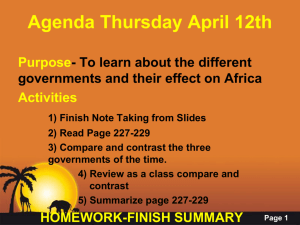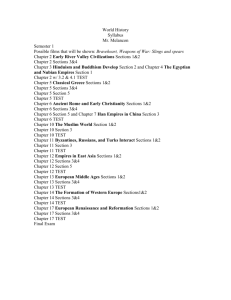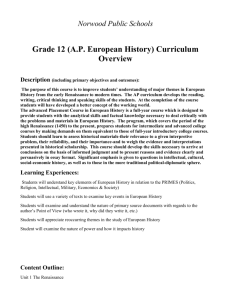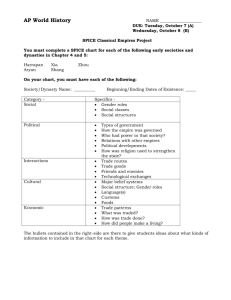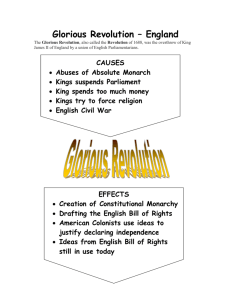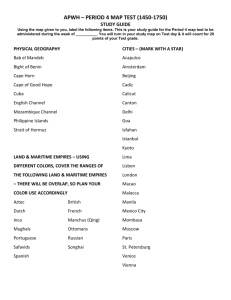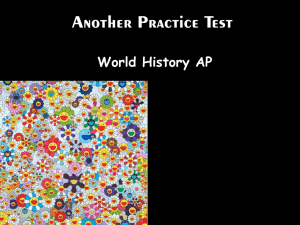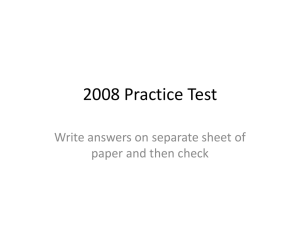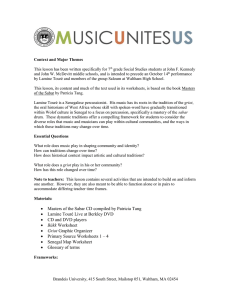AP World History School Course Description and Expectations
advertisement
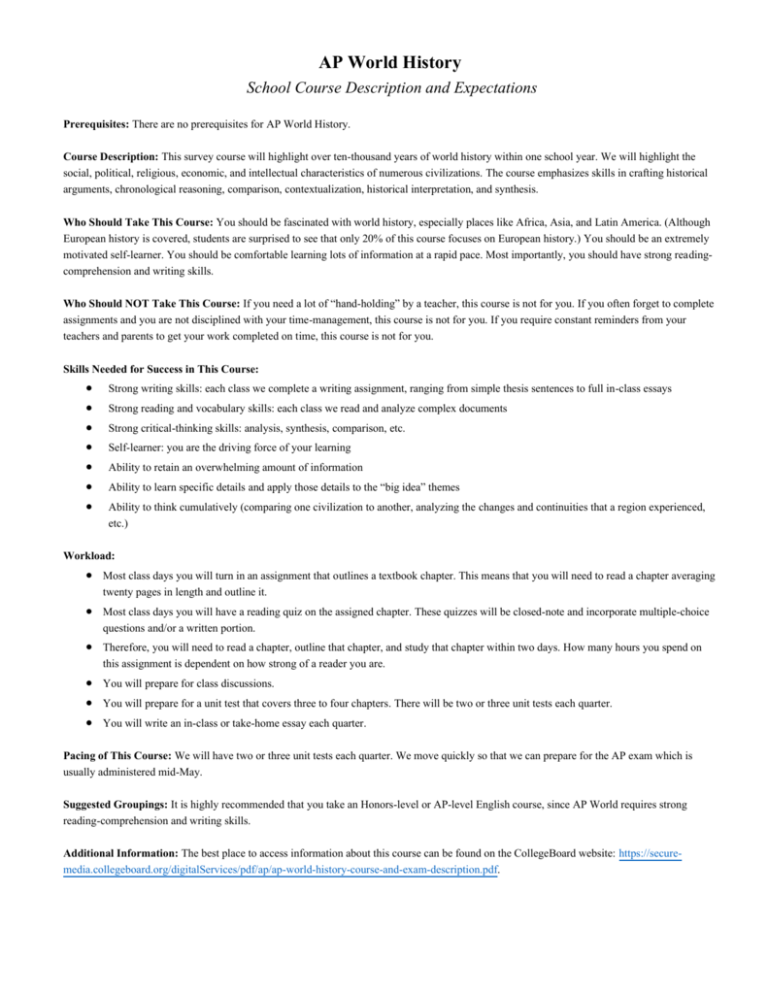
AP World History School Course Description and Expectations Prerequisites: There are no prerequisites for AP World History. Course Description: This survey course will highlight over ten-thousand years of world history within one school year. We will highlight the social, political, religious, economic, and intellectual characteristics of numerous civilizations. The course emphasizes skills in crafting historical arguments, chronological reasoning, comparison, contextualization, historical interpretation, and synthesis. Who Should Take This Course: You should be fascinated with world history, especially places like Africa, Asia, and Latin America. (Although European history is covered, students are surprised to see that only 20% of this course focuses on European history.) You should be an extremely motivated self-learner. You should be comfortable learning lots of information at a rapid pace. Most importantly, you should have strong readingcomprehension and writing skills. Who Should NOT Take This Course: If you need a lot of “hand-holding” by a teacher, this course is not for you. If you often forget to complete assignments and you are not disciplined with your time-management, this course is not for you. If you require constant reminders from your teachers and parents to get your work completed on time, this course is not for you. Skills Needed for Success in This Course: Strong writing skills: each class we complete a writing assignment, ranging from simple thesis sentences to full in-class essays Strong reading and vocabulary skills: each class we read and analyze complex documents Strong critical-thinking skills: analysis, synthesis, comparison, etc. Self-learner: you are the driving force of your learning Ability to retain an overwhelming amount of information Ability to learn specific details and apply those details to the “big idea” themes Ability to think cumulatively (comparing one civilization to another, analyzing the changes and continuities that a region experienced, etc.) Workload: Most class days you will turn in an assignment that outlines a textbook chapter. This means that you will need to read a chapter averaging twenty pages in length and outline it. Most class days you will have a reading quiz on the assigned chapter. These quizzes will be closed-note and incorporate multiple-choice questions and/or a written portion. Therefore, you will need to read a chapter, outline that chapter, and study that chapter within two days. How many hours you spend on this assignment is dependent on how strong of a reader you are. You will prepare for class discussions. You will prepare for a unit test that covers three to four chapters. There will be two or three unit tests each quarter. You will write an in-class or take-home essay each quarter. Pacing of This Course: We will have two or three unit tests each quarter. We move quickly so that we can prepare for the AP exam which is usually administered mid-May. Suggested Groupings: It is highly recommended that you take an Honors-level or AP-level English course, since AP World requires strong reading-comprehension and writing skills. Additional Information: The best place to access information about this course can be found on the CollegeBoard website: https://securemedia.collegeboard.org/digitalServices/pdf/ap/ap-world-history-course-and-exam-description.pdf. AP World History Multiple-Choice Sample Questions _____1. Before 500 C.E., Judaism and Hinduism were similar in that both A. B. C. D. Had written scriptures and an ethical code to live by Spread widely around the Mediterranean Promoted teachings about reincarnation Advocated a monastic life and rejection of the world 6. Which of the following statements is true about both the Mughal and Ottoman empires in the sixteenth century? A. B. C. D. _____2. Which of the following was an important reason for the fall of the Roman, Han, and Gupta empires? A. B. C. D. A long period of drought that destroyed crops and livestock The use of slaves in their armies Intensified invasions and security issues long their frontiers A refusal to tolerate Christianity The Crusader states were able to cling to survival only through frequent delivery of supplies and manpower from Europe. [They] were defended primarily by three semi-monastic military orders: the Templars, the Hospitallers, and the Teutonic Knights. Combining monasticism and militarism, these orders served to protect pilgrims and to wage perpetual war against the Muslims. I am a griot… we are vessels of speech; we are the repositories which harbor secrets many centuries old. Without us the names of kings would vanish into oblivion. We are the memory of mankind; by the spoken word we bring to live the deeds and exploits of kings for younger generations… I teach kings the history of their ancestors so that the lives of the ancients might serve them as an example, for the world is old, but the future springs from the past. An African griot introducing the epic of King Sundiata of Mali, composed circa 1400 C.E. 7. The introduction by the griot is intended to serve which of the following purposes? A. Palmira Brummett, world historian, 2007 Whenever I visited Jerusalem, I always entered the al-Aqsa Mosque beside which stood a small mosque which the Franks had converted into a church… [T]he Templars, … who were my friends, would evacuate the little adjoining mosque so that I could pray in it. Usamah ibn Munqidh, Muslim historian, Jerusalem, circa 1138 _____3. The second passage does not support the first passage because the second passage A. B. C. D. Shows that an influx of manpower from Europe was not critical for the survival of the Crusader states Shows that Muslims vastly outnumbered Europeans in the Crusader states Minimizes the importance of Hospitallers and Teutonic Knights in the administration of the Crusader states Presents an incident in which a military order supported a Muslim traveler _____4. Which of the following European developments is most closely associated with the revolution in Haiti? A. B. C. D. The Protestant Reformation The Russian Revolution The French Revolution The Industrial Revolution _____5. All of the following factors contributed to significant grown in worldwide population from 1750 through 1900 EXCEPT A. B. C. D. Decline of epidemic disease Introduction of Western Hemisphere food crops to new areas Expansion of land under cultivation New grain crops developed in the Green Revolution In both empires the majority of the people were Muslims. Both empires had powerful navies that engaged European navies. Both empires expanded through the use of gunpowder weapons and extensive bureaucracies. Both empires gave little monetary support to artistic and cultural endeavors. B. C. D. The establish the griot’s authority by connecting him to the past To exalt the Malian kings above previous dynasties To highlight the griot’s unique abilities compared with other griots To portray Mali as a progressive society that is improving on the past Sample CCOT Essay prompt: Analyze continuities and changes in cultural beliefs and practices in ONE of the following regions from 1450 to the present. Sub-Saharan Africa Latin America/Caribbean Sample Comparison Essay prompt: Analyze similarities and differences in techniques of imperial administration in TWO of the following empires. Han China (206 B.C.E. – 220 C.E.) Mauryan/Gupta India (320 B.C.E. – 550 C.E.) Imperial Rome (31 B.C.E. – 476 C.E.) Did you notice? The cumulative nature of these questions (making comparisons, for example) The need to memorize specific information AND be able to apply those details to bigger themes More sophisticated wording and vocabulary of questions These samples are reflective of the type of assessment questions you will do most class periods. Answers 1. A 2. C 3. D 4. C 5. D 6. C 7. A
